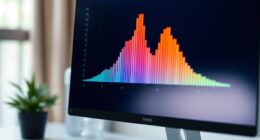To gain an advantage in SAS, learn to harness macros for automating repetitive tasks and creating reusable code, saving you time and reducing errors. Enhance your data visualizations with PROC SGPLOT and customize charts for clearer insights. Automate report generation to guarantee consistency across multiple datasets, freeing up time for deeper analysis. Mastering these hidden tricks makes your work more efficient and impactful. Keep exploring these strategies to open even more powerful techniques.
Key Takeaways
- Master macro programming to automate repetitive tasks and create reusable, dynamic code for efficient workflows.
- Use PROC SGPLOT and PROC SGRENDER to generate customized, insightful visualizations that enhance data interpretation.
- Automate report generation with macros to ensure consistency, save time, and improve presentation quality.
- Build a macro library gradually to streamline analysis processes and increase overall productivity.
- Improve report clarity by using clear language and visualizations, and leverage tools like passive voice detection for polished outputs.

Are you looking to boost your efficiency with SAS? If so, understanding some lesser-known tips can make a real difference in your workflow. One of the most powerful tools at your disposal is macro programming. While it might seem intimidating at first, mastering macros allows you to automate repetitive tasks, saving you hours of manual coding. Instead of rewriting similar code snippets for different datasets or analyses, you can create flexible macros that adapt to various inputs. This not only speeds up your work but also reduces errors, since you only need to update the macro code once for multiple uses. For example, you can design a macro that generates summary statistics, creates plots, or exports datasets, all with simple macro calls. By leveraging macro programming, you turn your SAS environment into a more dynamic and efficient tool, freeing up time for deeper analysis or exploring new techniques.
Another area where many students and even some professionals overlook opportunities is data visualization. While SAS offers a range of procedures for producing charts and graphs, knowing how to effectively visualize your data can transform raw numbers into compelling insights. Instead of dumping raw output into tables, invest time in customizing your visualizations. Use PROC SGPLOT or PROC SGRENDER to craft clear, informative graphs that highlight trends, outliers, or relationships. Incorporate color, labels, and annotations thoughtfully to make your visuals stand out. Good data visualization isn’t just about making pretty pictures; it’s about communicating your findings in an understandable, impactful way. When you combine macro programming with data visualization, you can generate customized reports automatically, complete with tailored charts that update as your data changes. Imagine running a single macro that produces a set of insightful charts for each subset of your data — that’s efficiency in action.
Many students underestimate how much time they can save by scripting repetitive tasks and automating report generation. Instead of manually creating plots and summaries for each dataset, write macros that handle these procedures in the background. This approach not only speeds up your analysis but also guarantees consistency across reports, which is vital for maintaining quality. As you grow more comfortable with macro programming, you’ll find it easier to incorporate advanced visualization techniques into your workflow. This will make your reports more professional and your insights more compelling. Remember, the key is to start small—automate simple tasks first and gradually build up your macro library. Over time, you’ll develop a toolkit that makes your SAS work faster, smarter, and more effective, giving you an edge in your coursework and future projects. Additionally, understanding passive voice detection can help you craft clearer, more direct reports that better communicate your findings.
Frequently Asked Questions
How Can I Improve SAS Code Efficiency Beyond Basic Tips?
To boost your SAS code efficiency beyond basic tips, focus on macro optimization to streamline repetitive tasks and reduce processing time. Also, improve data step efficiency by minimizing unnecessary data movements, using appropriate indexing, and avoiding redundant computations. You can further enhance performance by consolidating steps, utilizing SAS functions effectively, and profiling your code with tools like PROC OPTMODEL or SAS Enterprise Guide. These strategies help your code run faster and more smoothly.
What Are Common Mistakes Students Make With SAS Programming?
When working with SAS programming, you often make mistakes like overlooking syntax errors or poorly handling data management. You might forget to check your code for typos, leading to errors, or mismanage datasets, causing inefficiencies. To improve, double-check your syntax carefully and organize your data steps clearly. Avoid rushing through code, and always validate your data to prevent mistakes that could compromise your analysis.
How Do I Troubleshoot Complex SAS Errors Effectively?
Troubleshooting complex SAS errors is like being a detective solving a mystery; you need sharp error diagnosis skills and effective debugging strategies. Start by carefully reading error messages, checking log details, and isolating problematic code sections. Use options like PROC LOG or macro debugging tools. Break down your code into smaller parts, test each individually, and document your steps. This systematic approach helps you uncover hidden issues and resolve errors efficiently.
Are There Hidden Features in SAS That Can Save Time?
You might wonder if there are hidden features in SAS that can save time. Yes, there are hidden shortcuts and secret commands tucked away in the software that can boost your efficiency. Exploring documentation, forums, and user communities reveals these lesser-known tools. By leveraging these hidden features, you’ll streamline your workflows, troubleshoot faster, and handle complex tasks more effectively, giving you an edge in your data analysis projects.
How Can I Master Advanced SAS Techniques Quickly?
To master advanced SAS techniques quickly, focus on hands-on practice with data visualization and macro programming. Immerse yourself in real-world projects, experiment with creating dynamic visuals, and automate tasks using macros. Leverage online tutorials and SAS documentation to deepen your understanding. Consistent practice, combined with exploring these powerful features, helps you build expertise faster and boosts your efficiency in handling complex data analysis tasks.
Conclusion
Now that you’ve got these SAS tips under your belt, you’re ready to tackle your projects with confidence. Remember, mastering SAS is a journey, not a sprint, so don’t be afraid to learn as you go. Keep practicing and exploring new tricks—you never know when a small tip might save your day. With persistence, you’ll find yourself swimming through data like a fish in water, turning complex problems into simple solutions.










